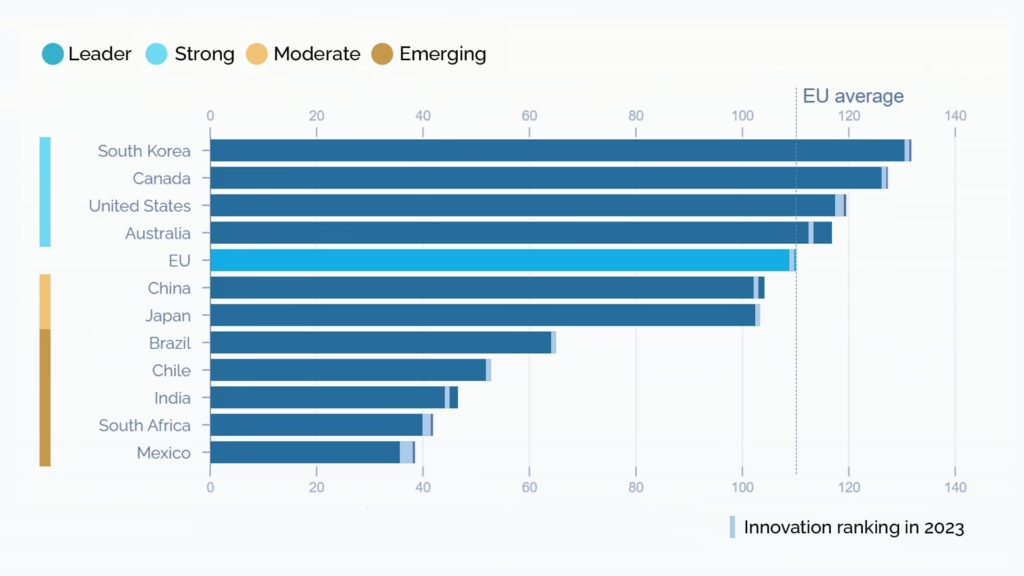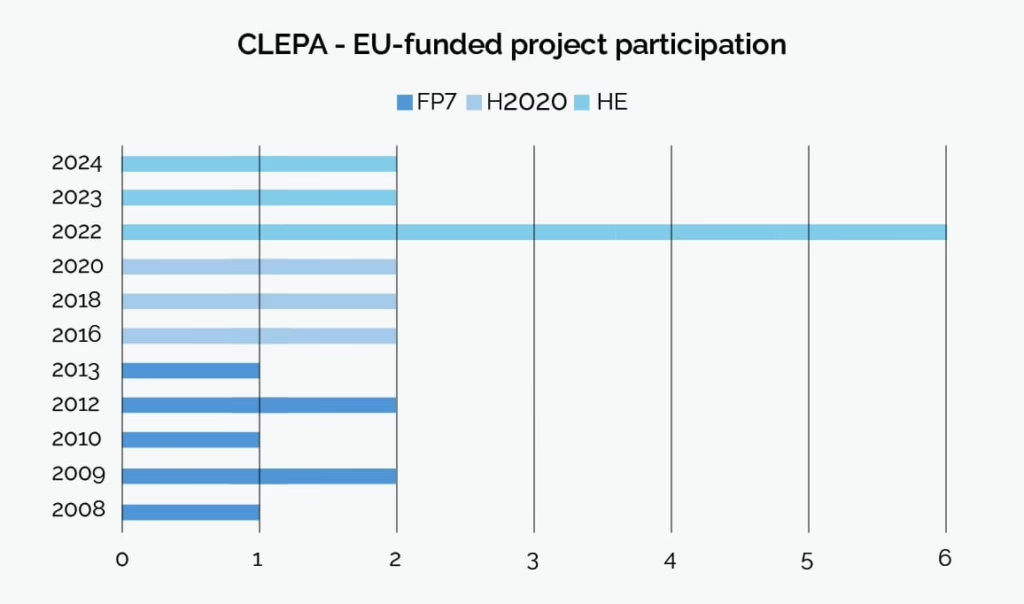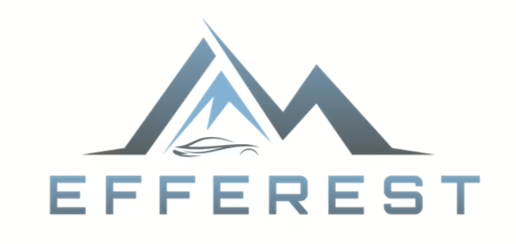CLEPA’s role in fostering EU innovation
CLEPA strongly supports and recognises the importance of Research and Innovation (R&I) in Europe.
In 2024, the European Union increased its innovation performance by 0.8% compared to 2023 (source: European Innovation Scoreboard). As shown in Fig.1, Europe is positioned between the moderate and strongest world innovators, compared to other global competitors.

CLEPA is actively contributing to the European landscape for innovation. Since 2008, CLEPA has been involved in 23 EU-funded initiatives and continues being a partner in many new project proposals.

As automotive suppliers play a key role in innovating and adapting the automotive industry to meet new global societal challenges and regulatory requirements, CLEPA’s R&I department, provides its support to the various innovation-related initiatives, with three main focus areas: Circularity & advanced materials, Energy & environment, and Safety, automation & connectivity. Furthermore, within the overall European innovation landscape, CLEPA is contributing to these key topics: skills, automation – connectivity – electrification – alternative powertrains and advanced circularity (Figure 3).

Circularity and advanced materials

| The project aims to transform The Safe-and-Sustainable-by-Design community in Europe and globally towards a lifecycle approach, in which safety, climate neutrality, circularity and functionality are integrated already in the design and manufacturing phase. |
| Expected results 1. Establishment of an Inclusive Safe and Sustainable by Design Ecosystem 2. Creation of Comprehensive Safe and Sustainable by Design Roadmaps 3. Development of a Sustainable Network of Experts |

| ‘Respect’ seeks to redefine the battery recycling process and create new sustainable and circular markets across Europe’s Li-ion battery value chain, reinforcing supply security and supporting strategic autonomy. |
| Expected results 1. Developing a Li-ion battery recycling process with advanced pre-treatment and hydrometallurgy to achieve over 90% materials recovery efficiency. 2. Implementation of innovative processes adaptable to various battery chemistries and designs. 3. Developing of the full Life Cycle Assessment of the recycling prosses. |
Energy and environment

| The ‘EFFEREST’-project’s mission is to leveraging real fleet data to enhance energy efficiency and user acceptance. Focusing on personalised performance options, adaptive digital twins, and AI-driven control systems. Making EVs more efficient comfortable and affordable through innovations in powertrains, batteries, and Heating, Ventilation, and Air Conditioning (HVAC). |
| Expected results 1. Improved systems and components linked to cabin comfort 2. Improved systems and components linked to powertrain performance 3. Physical and virtual demonstrator under realistic conditions |
| ‘GIANTS’ is focused on creating an innovative lightweight electric vehicle platform that offers affordable and accessible mobility solutions for both emerging and advanced markets. Focusing on user demands, it features modularity, scalability, and advanced energy optimisation. The platform will enhance urban transport, improve air quality, and promote user acceptance while reducing ownership costs. |
| Expected results 1. Develop a sustainable modular design enhancing repairability and recyclability 2. Develop an affordable lightweight vehicle for both passenger and cargo transport 3. Enhance the competitivity of the EU in L-category (2- and 3-wheel vehicles and quadricycles) vehicle international markets |

| Enhanced EV battery performance, safety, and longevity with a focus on sustainability. Key objectives include a 500 km range, faster charging, ultimate safety, 300,000 km first-life battery lifespan, second-life applications, and full lifecycle sustainability. Improving energy density, thermal management, and innovative dismantling procedures for efficient recycling and reuse. |
| Expected results 1. Achieve short charging time (under 20 minutes) 2. Achieve a safe and sustainable battery system 3. Achieve extended range on a single charge (500 km) and improved battery lifetime (300,000 km) |

| ‘VERA’ is developing innovative retrofit solutions for tailpipe and brake emissions in high-mileage city vehicles. Focusing on reducing particles, nitrogen oxides (Nox), and ammonia (NH3) emissions, using adaptable systems for cost-effective optimisation. Including active filtration and innovative brake components, assessing environmental and health impacts through cost-benefit analysis. |
| Expected results 1. Develop tailpipe retrofit solutions reducing the emissions of NOx (by 60%) and NH3 particles while reducing the cost of application 2. Develop bake retrofit solutions reducing the emission of particles by 90% and cost of application 3. Develop retrofit tailpipe and brake solutions for different categories of vehicles. |
Safety, automation and connectivity
| ‘FAME’s’ goal is the development of common methodologies and tools to share best practices support collaboration within CCAM stakeholders’ community with a long-term coordination framework for R&I. Building on EU-funded projects like ARCADE, CARTRE, VRA and FOT-Net, the Common Evaluation Methodology aims at improving cooperation and building consensus |
| Expected results 1. Establish a CCAM comprehensive demonstration and testing framework, including a Test Data Space. 2. Develop a common Evaluation Methodology for CCAM demonstration projects and pilots 3. Provide a platform, tools and forum for active CCAM stakeholder engagement and consensus building. 4. Enriched, intelligent and more user-oriented Knowledge Base on CCAM |
| ‘MODI’ drives the introduction of CCAM vehicles in logistics, enabling automated freight transport through five European countries. Key results include Heavy-Duty Vehicles at TRL7, the interface with CCAM vehicles and the setup of physical and digital infrastructure for the use of SAE L4 trucks on motorways. |
| Expected results 1. Interface for the coordination of vehicles inside and outside confined areas, while adding more benefits to the use of CCAM vehicles thanks to the increased efficiency achieved with coordination. 2. Heavy duty vehicles suitable for demonstration for the selected use cases along the motorway corridor between Norway and The Netherlands 3. Set-up of digital and physical infrastructure validated and created in co-design by relevant stakeholders for the use of Level 4 (L4) automated trucks on motorways. |
| ‘SYNERGIES’ is creating a European platform, to advance the development, training, virtual testing and validation of CCAM systems. It builds on two previous EU-funded projects: HEADSTART and SUNRISE, providing stakeholders with scenario databases, and a marketplace to ensure continual updates, while prioritising safety and data protection. |
| Expected results 1. SYNERGIES Platform with scenarios generated via a wide range of data-based, knowledge-based, Generative AI methods and crowd-sources from society through online platform. 2. Open datasets from diverse sources 3. Best practices for data gathering and scenario extraction and identification 4. Stakeholders’ engagement, international cooperation and promotion to standardisation 5: Scenarios specific for AI training and development with hyper parametrisation of each scenario to tackle bias. |
By clicking the subscribe button you agree that CLEPA can process your personal data as detailed in our privacy policy

